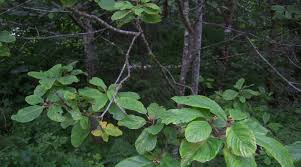Cascara Sagrada A.K.A. Sacred Bark Herb

Cascara sagrada is the commercial name for a tree whose botanical name is Rhamnus purshiana. Cascara sagrada is a species of buckthorn and its traditional or common names used by Native Americans include sacred bark, chittam bark bearberry persiana bark, and purschiana bark.
The sacred bark herb is made from the bark of the cascara sagrada tree or shrub, which is native to the pacific northwest of North America and includes areas south of British Columbia eastward to northwestern Montana and southward to central California.
Native Americans used the term sacred bark because of the wide range of cascara sagrada benefits.
Relieves Constipation
The bark of the cascara sagrada plant contains anthraquinone compounds that is used widely in many commercial products to relieve constipation and upset stomachs. Anthraquinones act as a laxative causing peristaltic action in the colon. Peristaltic action is the worm-like movement of muscles in the colon that moves waste through the colon.
A whole food plant-based diet maximizes peristaltic action because dietary fiber stimulates peristalsis, while the consumption of meat, dairy, and processed foods inhibit peristalsis.
Toning of the Intestinal Tract
Cascara sagrada bark herb and also high fiber plant-based foods stimulate peristalsis. This worm-like contraction helps to push waste out of diverticula that compromise the structure of the intestinal wall and intestinal function. Removal of waste from the intestines allow them to to heal and regain original tone and function.
Anti-Cancer
Scientific studies have shown that the anthraquinone aloe emodin which is present in cascara sagrada has anti-cancer properties. It presents activity against neuroectodermal tumors, which are tumors of the central or peripheral nervous system,[1] stomach cancer,[2] and lung cancer[3].
The anthraquinone emodin in sacred bark has been shown to have neuroprotective properties,[4] liver protective properties,[5] and chemo-preventive properties.[6][7][8]
Traditional Medicine
Cascara sagrada bark has been used in traditional medicine for hundreds of years to treat a variety of disorders including high blood pressure, congestion, gallstones, gas, hemorrhoids, liver disorders, and nervous disorders. One thing to remember about traditional medicine is its benefits are often dismissed until Western science validates them, which doesn’t mean this benefits aren’t real and only means western science hasn’t caught up.
Removes Soft Tissue Calcification
My primary interest in cascara sagrada is Dr. Sebi’s use of it is his lymphalin products. Dr. Sebi uses cascara sagrada, hydrangea root, red clover, mulato to break up calcification in soft tissue which provides safe haven for viruses and bacteria.
Breaking up the calcification in soft tissue removes the barrier and allows nutrients and phytonutrients kill pathogens and neutralize toxins so they can be removed from the body.
Usage
Short-term or periodic use is recommended because long-term may result in diarrhea, electrolyte imbalance, and a dependence on the herb to stimulate peristaltic action. Pregnant women are cautioned against using the herb.
Learn more about cascara sagrada and other herbs used in Dr. Sebi’s methodology and how to use them in my book Alkaline Herbal Medicine.
Learn About Foods That Support Health and Vitality on the Dr. Sebi Nutritional Guide »
[1] Aloe-emodin Is a New Type of Anticancer Agent
[2] Aloe-emodin-induced apoptosis in human gastric carcinoma cells
[3] Effects and mechanisms of aloe-emodin on cell death in human lung squamous cell carcinoma (Lung cancer)
[4] Neuroprotective Effects of Emodin
[5] Hepatoprotective Effect of Emodin
[6] Chemo-preventive Effects of Emodin
[7] Apoptosis-inducing activity of New Pyrazole Emodin
[8] Emodin-Induced Apoptosis in Human Breast Cancer
Tags: herbs






